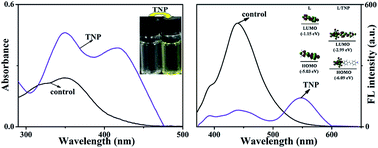A small-molecule chemosensor for the selective detection of 2,4,6-trinitrophenol (TNP)†
Abstract
A pyridine-based small-molecule receptor (L) for the specific recognition of TNP was synthesised and characterised by 1H NMR, 13C NMR and FT-IR spectra, and the optical properties were studied by UV-Vis absorption and PL spectra. The results showed that the fluorescence of L was strongly quenched by picric acid accompanied by an obvious colour change from transparent to yellow, which indicated that the receptor L can serve as a small-molecule sensor for TNP. Crystal structure determination and theoretical calculation of the corresponding host–guest complex L·TNP were also performed.


 Please wait while we load your content...
Please wait while we load your content...